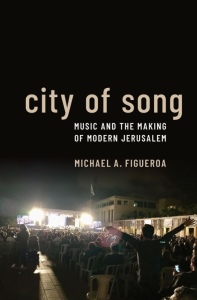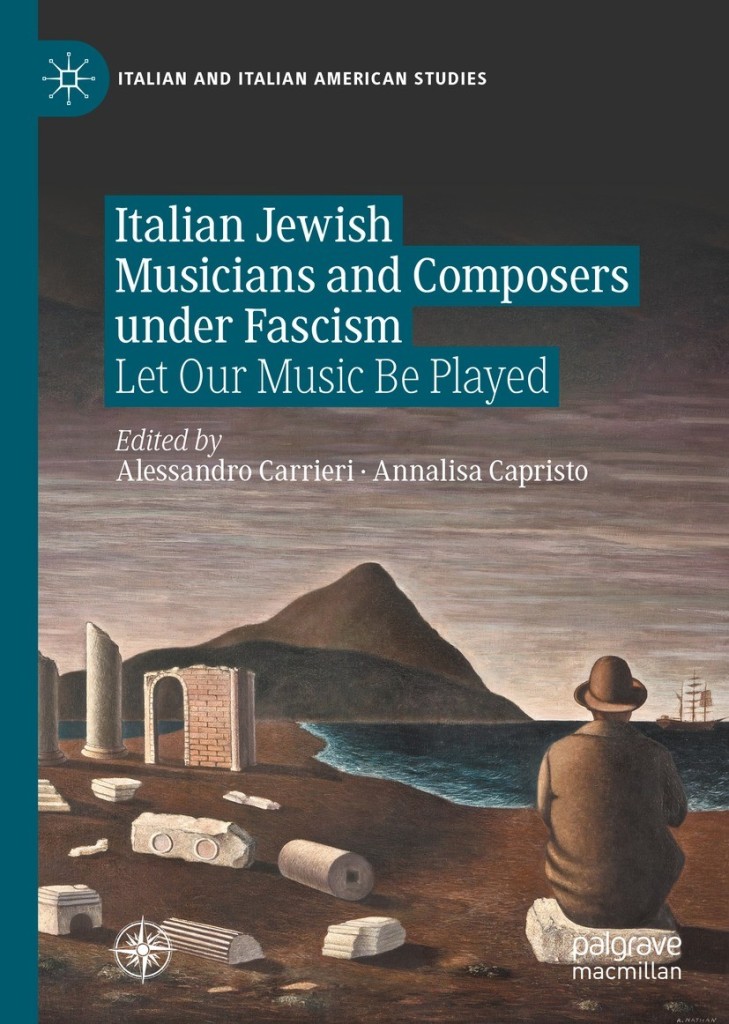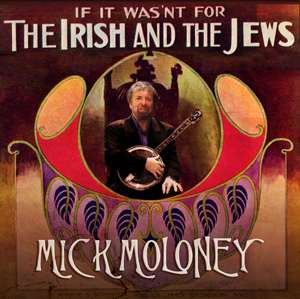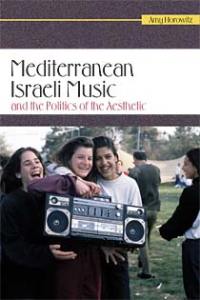You are currently browsing the tag archive for the ‘Popular Music’ tag.
City of Song: Music and the Making of Modern Jerusalem. Michael A. Figueroa. Oxford: Oxford University Press. 2022.
Reviewed by Tanya Sermer

Michael A. Figueroa’s captivating City of Song: Music and the Making of Modern Jerusalem is a book about Jerusalems—high/low, celestial/terrestrial, metaphorical/material—and how musical representations of the city have produced a multiplicity of political imaginaries about those Jerusalems in modernity. Combining an impressive array of interdisciplinary theory, historical and archival study, ethnographic fieldwork, and close listening to songs in Hebrew about the city, Figueroa creates a sophisticated framework for understanding how music and poetry (from the Psalms through Israeli popular song of the 1970s) have been used to create subjective and changing “spatial knowledge” about Jerusalem among Zionist Jews and Israelis over the course of the twentieth century. Presenting a remarkably nuanced exploration of the contested meanings inherent in cultural output regarding the city, Figueroa is deliberate in his relational approach to the people and spaces in his study; discussions of Jerusalem throughout the book consider the perspectives and concerns of Palestinian Arabs, Armenians, or ethnic and religious divisions within the Jewish and Israeli populations. Figueroa’s commitment to a relational approach—a growing body of such scholarship in musical studies of Israel and Palestine that aims to break down the mutual exclusion of those two national narratives as well as the conventional dichotomies within them—offers the reader a rich picture of the social and political forces at play and the greater implications of the territorial imaginaries that underpin the songs Figueroa examines.
Read the rest of this entry »Let Our Music Be Played: Italian Jewish Musicians and Composers under Fascism. Edited by Alessandro Carrieri and Annalisa Capristo. Cham, Switzerland: Palgrave Macmillan. 2021.
Reviewed by Jesse Rosenberg

The last twenty years have witnessed significant developments in scholarship concerning antisemitism in Italy during the ventennio, the twenty-year period of Fascist rule (1923-1943). Thanks to historians such as Michele Sarfatti and Giorgio Fabre, the benign view which had hitherto prevailed with regard to the antisemitic laws promulgated by the Fascist government in 1938 — that these were adapted without conviction, in adherence to the dictates of a new alliance with Germany, and represented an unexpected about-face in the treatment of Italian Jews — have been definitively rebutted. The editors of this superlative collection of essays are aware of these newly-acquired insights (one of them, Annalisa Capristo, has co-authored an important book with Fabre), but also, to judge by the variety of approaches taken by the contributors to the book, equally cognizant of the complexities involved in applying these lessons to the field of music.
Read the rest of this entry »To Broadway, To Life! The Musical Theater of Bock and Harnick. Philip Lambert. New York: Oxford University Press, 2011. ISBN 978-0-1953-9007-0
Jews on Broadway: An Historical Survey of Performers, Playwrights, Composers, Lyricists and Producers. Stewart F. Lane. Jefferson, NC: McFarland, 2011. ISBN 978-0-7864-5917-9
Reviewed by Alisa Solomon

Like those Broadway musicals that are driven by deep emotion and a social conscience, intellectual books about Broadway musicals face a dilemma: how to be serious and popular. Indeed, books may have a harder time. From Showboat to Rent, musicals have managed to challenge audiences with questions about such issues as racism and AIDS even as they have filled the coffers of investors. But to whom is a book on Broadway addressed—to academic specialists or to die-hard show fans? Not that these categories are mutually exclusive (the best scholarship is typically driven by passion, after all), but they can represent vastly different cultures and interests. As publishers increasingly look for “crossover” projects—and as the academic study of musical theater expands—the clashing expectations of these disparate audiences can put some authors in a bind. Read the rest of this entry »
If It Wasn’t for the Irish and the Jews. Mick Moloney. Compass Records, 2009.
I first enjoyed Mick Moloney and The Green Fields of America some twenty years ago at a national meeting of the American Conference for Irish Studies. Moloney, a talented musician-singer and folklorist who is also a Professor of Music and Irish Studies at New York University, formed the group in the later 1970s and, at least in my memory of the evening, offered a program in which traditional reels, jigs, and step dancing predominated. In the past few years, however, Moloney’s considerable energies have been directed more specifically at America’s Tin Pan Alley era, a time in which Irish and Jewish songwriters—separately and collaboratively—created a popular music expressive of some of the moment’s most pervasive social issues: the struggles of newly arrived immigrants, their often tense internal negotiations between assimilation and nostalgia, and the specter of World War I. Moloney’s earlier album McNally’s Row of Flats (Compass, 2006) treats the highly successful collaboration of Edward Harrigan and David Braham; thus, If It Wasn’t for the Irish and the Jews might be regarded as a further iteration of Moloney’s fascination with American popular music between 1880 and 1920. Read the rest of this entry »
Playing Across a Divide: Israeli-Palestinian Musical Encounters. Benjamin Brinner. New York: Oxford University Press, 2009. 360 pp. ISBN 978-0-1953-9594-5
Some time in the late 1980s, at the height of the first Palestinian intifada, Israeli poet/lyricist/author/publicist Jonathan Geffen devoted one of his regular newspaper columns to Israeli music. Geffen, renowned as an eloquent cynic in his often dour critique of Israeli society, began his piece by articulating the general sense of shock and depression that had taken over much of Israeli cultural and intellectual life in that period, particularly among those identified with the country’s left-of-center political camp, for which Geffen was a spokesperson. Depressing though the situation was, Geffen wrote, there was one bright spot: In a country so small and crisis-ridden, the extent and range of musical creativity was to him a small piece of veritable redemption. Read the rest of this entry »
Mediterranean Israeli Music and the Politics of the Aesthetic. Amy Horowitz. Detroit: Wayne State University Press, 2010. xvii+251 pp. (+ 19 songs on CD). ISBN 978-0-8143-3465-2
Musiqa mizrahit, aka Israeli Mediterranean Music, is a category of popular music mostly known for its strong Middle Eastern and Greek tinges. It has been at the center of Israeli public discourse on popular music since the late 1970s. By 2010, the leading theme of this discourse is the “triumph” of the genre in the field of Israeli popular music. With prominent performers such as Sarit Hadad, Eyal Golan, Kobi Peretz, Moshe Peretz, Shlomi Shabat, Lior Narkis and others filling up the largest music venues in Israel, leading the sale charts and ruling the radio airwaves, Israeli Mediterranean Music is by 2010 the “mainstream” of Israeli popular music. Throughout its history, speakers for Israeli Mediterranean Music have insisted, against their marginalization, that this genre is the “true” Israeli authentic popular music, the one that should be at center stage of Israeli culture. Given the genre’s success in the 1990s and the 2000s, Edwin Seroussi and myself concluded some years ago that “the nationalist impetus that underlined musiqa mizrahit for decades has achieved its own self-declared goal of both bringing musiqa mizrahit into the mainstream of Israeli popular music and of affecting the sounds of all popular music in Israel.”[1] Read the rest of this entry »
Jews, Race and Popular Music. Jon Stratton. Burlington, VT: Ashgate, 2009. 238 pp. ISBN 978-0-7546-6804-6
In Jews, Race and Popular Music, Jon Stratton attempts to stage an intervention at the fulcrum of the peculiar relationship between Jews and popular music. The historical coincidence of Jewish people and African American musical styles—from Al Jolson to Amy Winehouse—has become something of a cottage industry both in and beyond the university (Stratton includes a comprehensive listing of titles in his introduction). In this work, Stratton is trying to reframe this well-documented yet still vexing area of research through the lenses of race and performance. The trouble is that he offers an argument that tries so hard to deconstruct Jewishness that he ends up reifying it.







